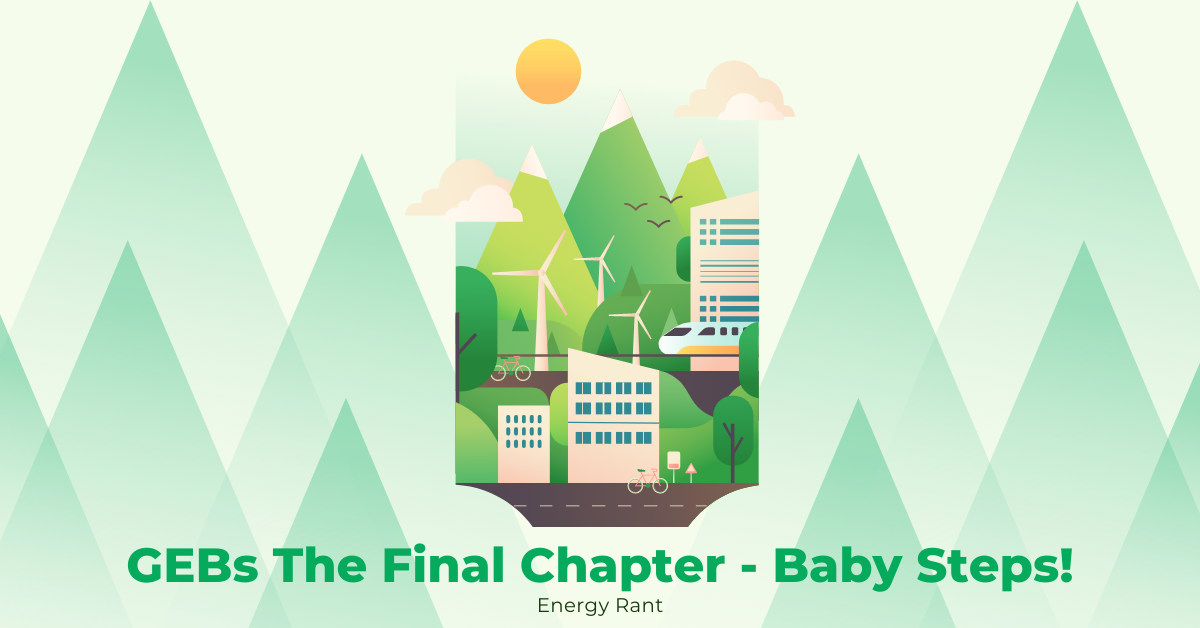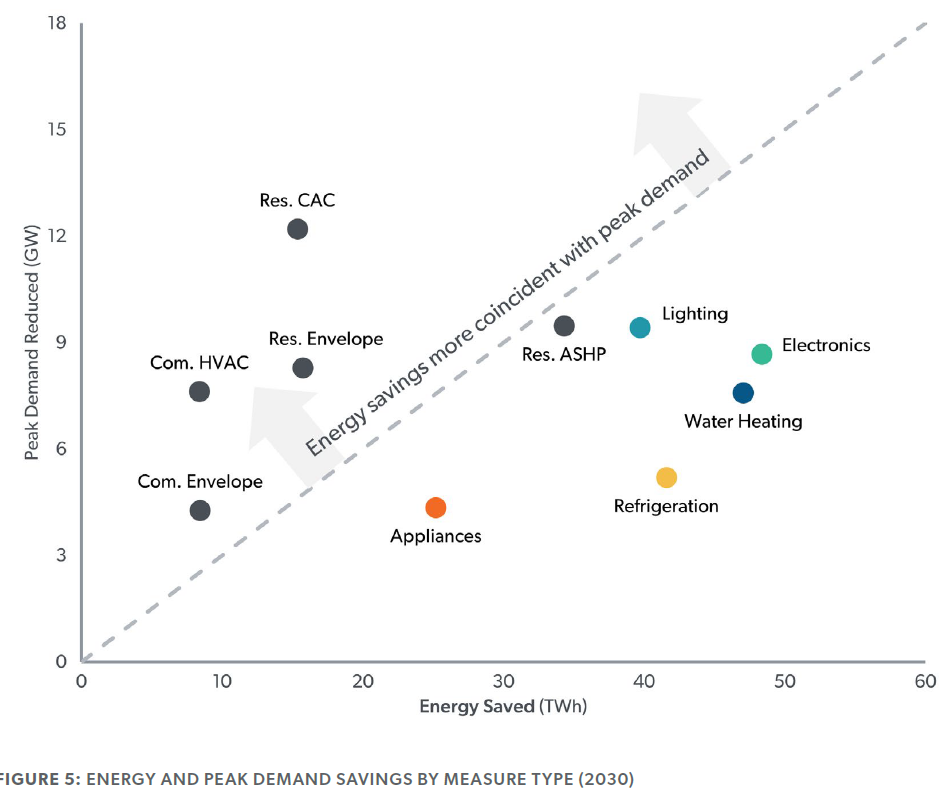
This is my sixth and final post on Grid-Interactive Efficient Buildings (GEBs), including the great interview with Doug Scott (#5) of the Great Plains Institute. This week, I will wrap up with a mishmash of items in the DOE’s GEB Roadmap.
As I start this wrap-up, what I wrote three years ago comes to mind – How About Some D in DSM? Here is the gist as it applies to GEBs today:
I have always found it interesting that “demand-side management,” the term that is generally used synonymously with energy efficiency programs, includes virtually no demand management whatsoever.
The term “demand-side” simply means the energy-consuming side of the energy transaction, whereas “demand” is an instantaneous power draw from a device, building, feeder line, substation, power plant, or an entire power grid.
To date, energy efficiency programs have primarily been in search of any kWh (energy) savings at any time. I call these kWh “dumb kWh.” So, we have dumb energy efficiency savings from a supposedly smart grid. Discuss.
Is this not where we are today? Interestingly DSM, aka efficiency, programs today are seeking long-lived measures to be more cost-effective. I.e., first-year savings that persist for 15 years, like major equipment replacement, are more valuable than activities like operations and maintenance and behavioral measures that may last one to three years. However, this demonstrates our DSM industry is still not in demand. Long-lived measures over demand-saving or demand-flexible savings is a partial policy failure.
Passive, But Not Necessarily Dumb
In a recent online GEB resource workshop, participants were asked about the types of measures that need to be deployed to decarbonize and reduce peak demand. Guess what measure was near the top – lowly, abused, forgotten, and left-for-dead envelope measures – windows, insulation, and construction tightness! Guess what – the GEB roadmap gives relatively high marks for enveloping measures, as shown in the following figure.
 Note that when “smart” control is applied to some of the measures below the line, they become excellent GEB resources. Those include anything with thermal storage – water heating and refrigeration. Commercial and industrial refrigeration applications offer enormous opportunities for GEBs by using phase change materials – water, saltwater solutions, and hydrocarbons like plant fats. Phase change materials can shift refrigeration load and demand out of peak periods every day. Get on it!
Note that when “smart” control is applied to some of the measures below the line, they become excellent GEB resources. Those include anything with thermal storage – water heating and refrigeration. Commercial and industrial refrigeration applications offer enormous opportunities for GEBs by using phase change materials – water, saltwater solutions, and hydrocarbons like plant fats. Phase change materials can shift refrigeration load and demand out of peak periods every day. Get on it!
GEB Barriers
The Roadmap lists the following top barriers to GEB deployment.
- Lack of interoperability
- EE and demand flexibility not included in planning activities (no kidding – see above)
- Technology is too costly and complex
- Consumers lack understanding or incentives
- Utilities and grid operators do not trust demand flexibility performance (but they do for demand response?)
- Utilities lack regulatory incentives
- Missing customer demand champions
Whether you are a solution provider or customer, your response to these barriers may be anything from “what are you talking about” to “no kidding.”
The “what are you talking about” crowd probably serves the residential sector with smart thermostats, some rate design, car charger controls, maybe a battery, and direct load control of a water heater. Compared to commercial and industrial, that is like ninth-grade algebra compared to advanced engineering math, where I lost my lust for mathematics applying calculus to infinite series functions.
Organizations in C&I facilities have jobs to do and money to make. Productivity is king, and energy costs are not likely to be in the top 10 issues. Not only are non-residential customers concerned far less about shaving a few bucks off their energy bills, their systems are a lot more complex, as noted by the roadmap. Those barriers are a massive mess to sort out for commercial and industrial customers.
GEB Ingredients
Here are some things that will alleviate GEB barriers.
Let The Market Work
Measuring what did and didn’t happen and then paying users for those hypothetical savings will never work with any level of reasonable cost and accuracy for commercial and industrial. Therefore, let prices fluctuate and give customers week ahead and day-ahead pricing data. Let them manage for themselves and with help from others as needed. This would help avoid all seven barriers.
Interactive?
There is tremendous value in both passive and active actions that do not require interactive technology. Load shifting, for example, can be done every day with phase change materials and no interactivity with the grid whatsoever. It saves money and resources every day. What is wrong with that? How interactive is insulation? If the technology doesn’t need to interact with the grid, most of these barriers disappear.
Performance-Based Ratemaking (Policy)
Performance-based ratemaking would solve many issues, but commissions and utilities need to burn the 100-year paradigms of constant growth and expansion. Why? Because electricity is becoming like cable TV and even satellite radio, which both grew in monopoly fashion, but for only a decade or two. Like those former monopolies, others are coming for your customers, utilities.
As we learned in the PBR interview, performance incentives can be based on anything. Think about that. Decoupling, the separation of sales volume from revenue, was considered a great thing to avoid conflicting objectives of utilities. They could maintain revenue with lost sales due to efficiency programs. PBRs would allow virtually anything – all kinds of ways to earn revenue and profit without building things. Rather than being rewarded for upsizing a substation or feeder, utilities could be rewarded for avoiding it.
The Last Hurrah
Like decarbonization, GEB deployment needs “science-based targets, with interim goals and detailed plans to achieve them.[1]”
Zero carbon by 2050? Let’s GEB everything now?
It’s not going to happen without the first step and plans for the next and the next. Put one foot in front of the other: baby steps, baby steps, baby steps. Move onward!
[1] Courtesy SEPA Utility Transformation Challenge recommendation #1.






